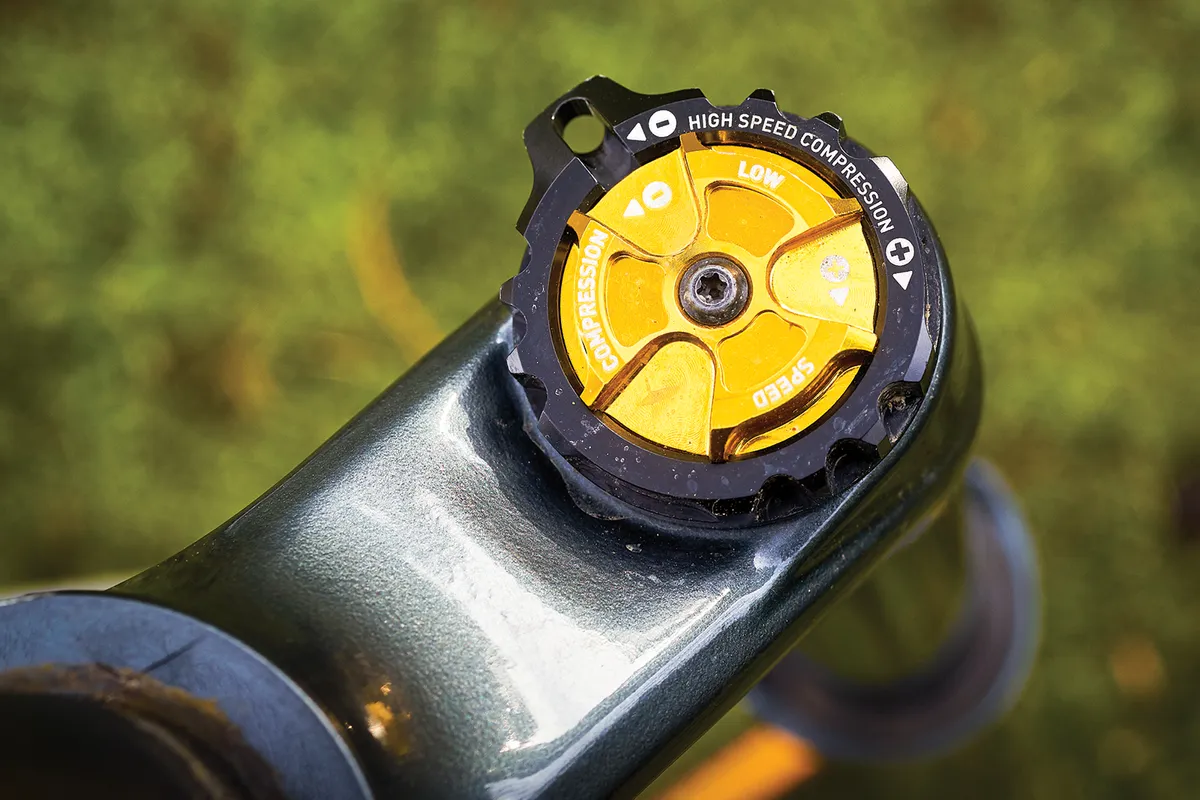Cane Creek’s D-Loc axle system is fiddly at first but can be installed faster than traditional axles once you get used to it. It can get clogged up by mud and grit in foul conditions though.
The air spring is travel-adjustable in 10mm increments all the way down to 100mm with no need to buy a different spring.
And while other forks use interchangeable volume spacers to adjust the progression of the spring, Cane Creek uses a piston which can be set to one of eight different positions to adjust the volume of the spring (and therefore its progression) with no need for separate parts.
The air spring is not self-equalising. Instead, there’s a button at the base of the leg to allow air to pass from the positive to the negative spring. Then you can let some air out of the positive chamber to get it working at its best.
- This fork was tested as part of a group test including ten of the best enduro forks. All forks were tested back-to-back on the same tracks, keeping all other variables as consistent as possible to ensure our findings are as reliable and accurate as they can be.
Cane Creek Helm Air setup
I spent far longer setting up the Helm than any other fork on test. The air spring has an overly-firm beginning stroke unless some air is released from the positive chamber after using the button to equalise the pressure in the spring.
But releasing more than two or three psi causes the fork to suck down into its travel noticeably, reducing the fork’s useable travel.
Getting the balance right is tricky even with a digital shock pump, and borderline guesswork with analogue. With 90psi in the negative spring and 88psi in the positive, small bump compliance was mid-pack but large rocks and holes were ironed out beautifully. However, the fork bottomed out far too easily.

Adding high-speed compression damping robbed it of comfort before fixing the problem. Reducing the volume of the positive chamber using the moveable piston (which acts like an adjustable volume spacer) and dropping the pressures to 85/80psi was the best solution I found.
But this setup effectively reduced the available travel by 10mm, and it still couldn’t match the comfort of any higher-scored forks despite still using all its travel on big hits.
Cane Creek Helm Air performance
Setup is key here. Once I had made the fork progressive enough to avoid bottoming out hard in mid-size landings, it lacked the impressive bump-swallowing comfort it exhibited to begin with.
Dropping the pressure in the positive spring and over-inflating the negative was necessary to provide enough small-bump sensitivity to rival the best on test.
However, this eats into some of the available travel – I measured 150mm from where the fork settled with 5psi more in the negative than the positive.
This could go some way to explaining why the Helm never felt as composed and comfortable over bigger hits as the best forks I tested and gave me more hand pain over long runs no matter what I did with the damper.
If you want a shorter-travel fork the Helm could be set up with even more pressure in the negative to suck it into its travel, but if you want 160mm of travel you’ll have to compromise on off-the-top sensitivity.
How does it compare to its main rivals?
I soon found a setup that was more sensitive and comfortable than I could manage with the Öhlins RXF 36 EVO, MRP Ribbon air and the X-Fusion Trace 36 HLR. But the air spring setup is a compromise between beginning-stroke sensitivity and long-run comfort, where the rest of the forks on test could out-perform the Helm in both regards at once.
This video shows how we tested the forks and how they compare.
Product
| Brand | Cane_creek |
| Price | A$1649.00, £900.00, $899.00 |
| Weight | 2081g |
Features
| Spring type | air |
| Wheel size | 29in_700c |
| Travel | 160.0000 |
| Travel | MILLIMETER |
| Features | Travel Options: 29in - adjustable 170-100mm in 10mm increments Travel Options: 27.5in - adjustable 160-100mm in 10mm increments Crown to axel length: 557mm (29in x 160mm) |
